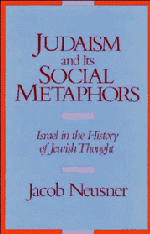Book contents
- Frontmatter
- Contents
- Preface
- List of Abbreviations
- Introduction
- 1 Imagining Society, Re-visioning “Israel”
- PART I “Israel” in the First Statement of Judaism, 70–300 C.E.
- 2 “Israel” in Relationship to Heaven
- 3 “Israel” in Relationship to “Non-Israel”
- 4 “Israel” in the Mishnah, the Tosefta, and Tractate Abot: A Probe
- 5 The First Phase of the Judaism of the Dual Torah and Its Social Metaphors
- PART II “Israel” in the Second Statement of Judaism, 300–600 C.E.
- PART III Same Metaphors, Other Systems
- General Index
- Index to Biblical and Talmudic References
2 - “Israel” in Relationship to Heaven
Published online by Cambridge University Press: 04 August 2010
- Frontmatter
- Contents
- Preface
- List of Abbreviations
- Introduction
- 1 Imagining Society, Re-visioning “Israel”
- PART I “Israel” in the First Statement of Judaism, 70–300 C.E.
- 2 “Israel” in Relationship to Heaven
- 3 “Israel” in Relationship to “Non-Israel”
- 4 “Israel” in the Mishnah, the Tosefta, and Tractate Abot: A Probe
- 5 The First Phase of the Judaism of the Dual Torah and Its Social Metaphors
- PART II “Israel” in the Second Statement of Judaism, 300–600 C.E.
- PART III Same Metaphors, Other Systems
- General Index
- Index to Biblical and Talmudic References
Summary
The Judaism of Sanctification
The doctrine of “Israel” implicit through the Mishnah, ca. 200 c.e., and explicit in many of its details may be stated very simply: The community now stands in the place of the temple of Jerusalem, destroyed in 70 c.e. What that meant is that the word for the social entity, “Israel,” would now serve, within the systemic structure at hand, as had the temple. The temple walls had marked the boundaries between holy and ordinary. So now did “Israel.” As in the vision of Ezekiel in chapters 40–47, the temple had marked the boundaries among the hierarchy of society, with the high priest going to the innermost sanctum, then the priests going closest to the holiest place, with others approaching in hierarchical distance: Levites, Israelite males, women, and onward outward. So now did “Israel” serve this second, inner-facing task of social hierarchization, as well as the outer-facing task of political differentiation of “Israel” from everyone else, “the nations.” Let me spell out the origins, sources, and structure of that metaphor of “Israel” as a social entity wholly apart and holy.
The Judaic system of the dual Torah began the first of the two stages of its formative history, the one marked by the Mishnah and related writings with an event comparable with the generative crisis of the pentateuchal system of ca. 586–450 b.c.e. It was yet another destruction of a Jerusalem temple, this one in 70 c.e. Specifically, the crisis precipitated by the destruction of the temple of Jerusalem in 70 c.e. centered attention on what can have endured beyond disaster.
- Type
- Chapter
- Information
- Judaism and its Social MetaphorsIsrael in the History of Jewish Thought, pp. 21 - 37Publisher: Cambridge University PressPrint publication year: 1989



